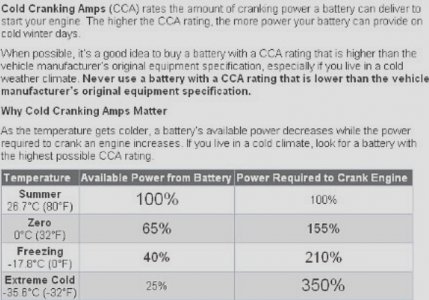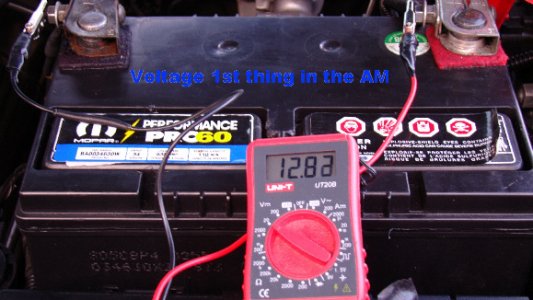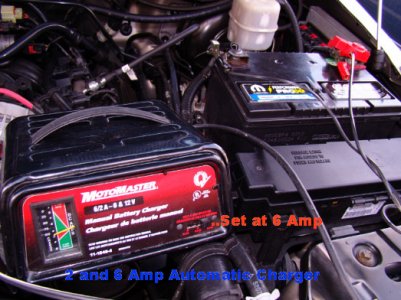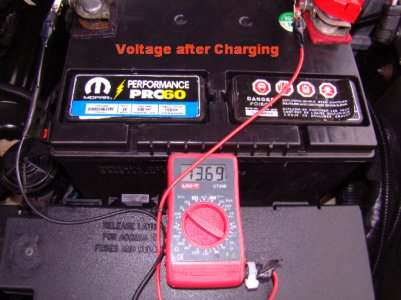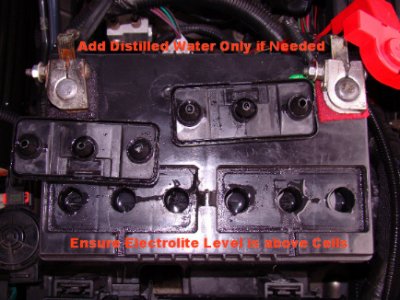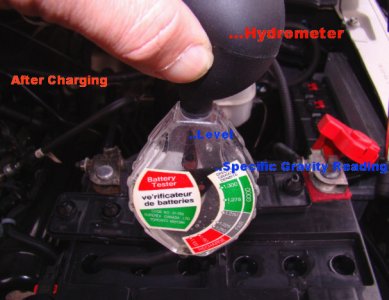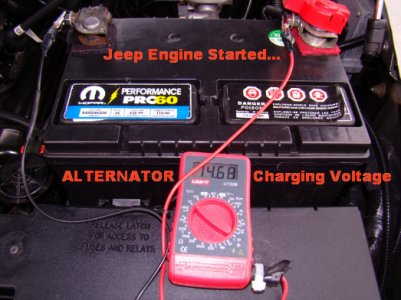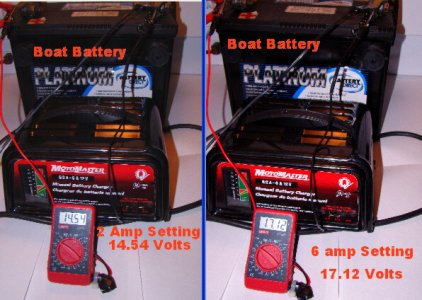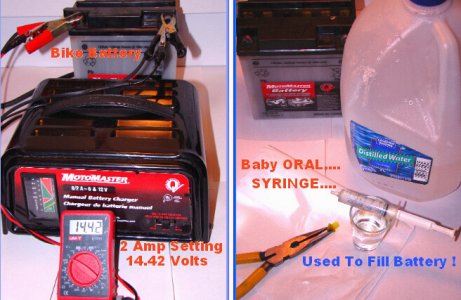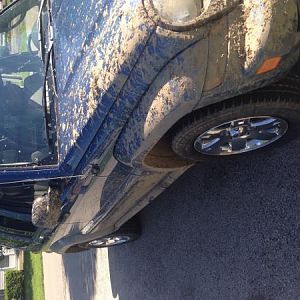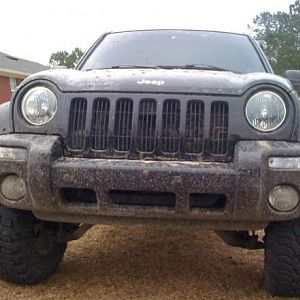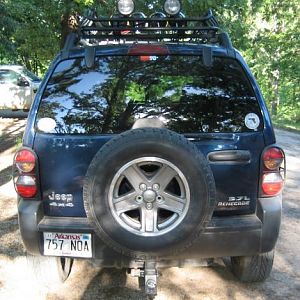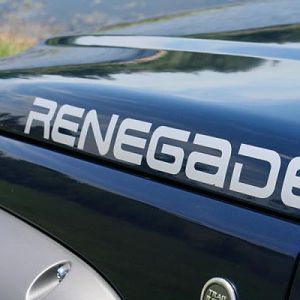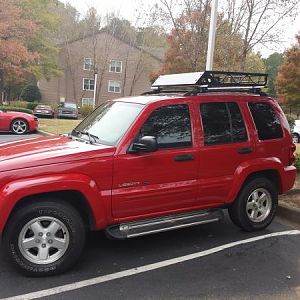What is the most neglected fluid in your Jeep? Answer: The electrolyte.
Even after you run around town with your lights on, Park, and then have your interior lights or stereo in use, is your battery really fully charged?
I will demonstrate how to charge & maintain & test the specific gravity of your lead acid battery with removable caps. This will keep your battery in top condition and should extend the life of your battery greatly!
I would recommend that everyone regardless of battery type, charge the battery & then have a load test done on your battery every fall. Volts multiplied by amps is important! One day soon, I hope to own a decent load tester!
Lead acid batteries with removable caps are recommended for those in warm to hot regions as you can add distilled water.(Rubber gloves & Eye protection, absolutely required when working around electrolyte)
The Chrysler stock battery is this type.
How does temperature effect batteries? Even with a new battery at 32F the cranking power is reduced by 35%.
37113[/ATTACH]"]
In chart above the "extreme cold folks" use battery blankets plugged in/block heaters/synthetic oils & or park inside!
As the temperature drops if you keep your battery charged & maintained, you wont be left in the cold.
Lead-acid batteries must be maintained at or near full charge to prevent deterioration of the lead plates inside READ! :http://www.aa1car.com/library/2003/us20310.htm
Inspect your Battery terminals to ensure they are free from corrosion and tight.
2.5 years later mine are clean cause they were coated in Vaseline!
In the am I check the voltage after sitting all night at 46F 12.82 Volts.
37115[/ATTACH]"]
12.82V is ok however, lets top it up, and use a manual charger, from 2 to 6 amps once a week for cooler temps(late fall/winter) & once a month in spring/summer temps.
Please read "Knowing Your Output Voltages" on the thread below for BCM (body control module) cautions,
If you are not going to remove the Jeep's Pos/Neg cables before charging.
37117[/ATTACH]"]
Charged 3 hours@ 6amps, Now Disconnected- off for 10 minutes, I have a great reading..a good sign of a strong battery!
37119[/ATTACH]"]
I suppose I should have started with this, I knew My electrolyte level was up, but lets see inside and check the level:
Wear eye protection and use rubber gloves around here. The electrolyte is highly corrosive and vapors flammable.
Have a gallon of water and baking soda ready near the Jeep, should a spill occur.
37121[/ATTACH]"]
And then lets see how that battery charge, improved the actual state of charge, by reading the specific gravity of the Electrolyte!
A strong battery should read well above 1.275 (mine is off the scale!)
Note:Check each cell ! If one is weak, it will show right away and may indicate it is time for a new battery!
Hydrometer Info Link: http://ezgo.smartmanual.biz/index.php?option=com_content&task=view&id=35&Itemid=127
37123[/ATTACH]"]
Now it is time to start the Jeep and check the Voltage going into the battery.
37125[/ATTACH]"]
I hope this helps....looks like my battery/charge is good.
Even after all of this..Load test your battery once a year in the fall. Many battery shops will perform this test for free.
In closing, I would like to add that if you have ever have found your battery dead, the best course of action is to check electrolyte level, & trickle charge that battery for 24 hours ASAP @ 2 amps. Then perform all the tests.
:favorites13:
Even after you run around town with your lights on, Park, and then have your interior lights or stereo in use, is your battery really fully charged?
I will demonstrate how to charge & maintain & test the specific gravity of your lead acid battery with removable caps. This will keep your battery in top condition and should extend the life of your battery greatly!
I would recommend that everyone regardless of battery type, charge the battery & then have a load test done on your battery every fall. Volts multiplied by amps is important! One day soon, I hope to own a decent load tester!
Lead acid batteries with removable caps are recommended for those in warm to hot regions as you can add distilled water.(Rubber gloves & Eye protection, absolutely required when working around electrolyte)
The Chrysler stock battery is this type.
How does temperature effect batteries? Even with a new battery at 32F the cranking power is reduced by 35%.
37113[/ATTACH]"]
You must be registered for see images attach
In chart above the "extreme cold folks" use battery blankets plugged in/block heaters/synthetic oils & or park inside!
As the temperature drops if you keep your battery charged & maintained, you wont be left in the cold.
Lead-acid batteries must be maintained at or near full charge to prevent deterioration of the lead plates inside READ! :http://www.aa1car.com/library/2003/us20310.htm
Inspect your Battery terminals to ensure they are free from corrosion and tight.
2.5 years later mine are clean cause they were coated in Vaseline!
In the am I check the voltage after sitting all night at 46F 12.82 Volts.
37115[/ATTACH]"]
You must be registered for see images attach
12.82V is ok however, lets top it up, and use a manual charger, from 2 to 6 amps once a week for cooler temps(late fall/winter) & once a month in spring/summer temps.
Please read "Knowing Your Output Voltages" on the thread below for BCM (body control module) cautions,
If you are not going to remove the Jeep's Pos/Neg cables before charging.
37117[/ATTACH]"]
You must be registered for see images attach
Charged 3 hours@ 6amps, Now Disconnected- off for 10 minutes, I have a great reading..a good sign of a strong battery!
37119[/ATTACH]"]
You must be registered for see images attach
I suppose I should have started with this, I knew My electrolyte level was up, but lets see inside and check the level:
Wear eye protection and use rubber gloves around here. The electrolyte is highly corrosive and vapors flammable.
Have a gallon of water and baking soda ready near the Jeep, should a spill occur.
37121[/ATTACH]"]
You must be registered for see images attach
And then lets see how that battery charge, improved the actual state of charge, by reading the specific gravity of the Electrolyte!
A strong battery should read well above 1.275 (mine is off the scale!)
Note:Check each cell ! If one is weak, it will show right away and may indicate it is time for a new battery!
Hydrometer Info Link: http://ezgo.smartmanual.biz/index.php?option=com_content&task=view&id=35&Itemid=127
37123[/ATTACH]"]
You must be registered for see images attach
Now it is time to start the Jeep and check the Voltage going into the battery.
37125[/ATTACH]"]
You must be registered for see images attach
I hope this helps....looks like my battery/charge is good.
Even after all of this..Load test your battery once a year in the fall. Many battery shops will perform this test for free.
In closing, I would like to add that if you have ever have found your battery dead, the best course of action is to check electrolyte level, & trickle charge that battery for 24 hours ASAP @ 2 amps. Then perform all the tests.
:favorites13:
Attachments
Last edited:


